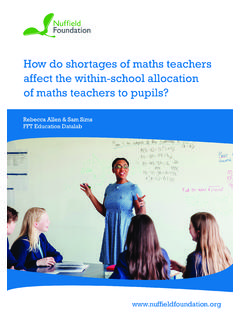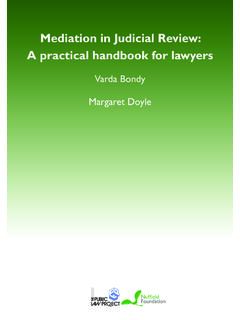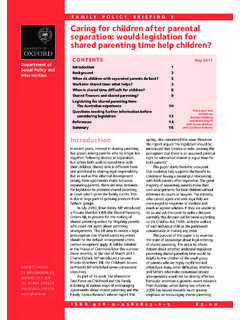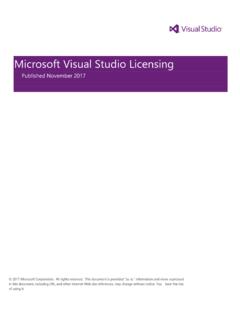Transcription of Developing the use of visual representations in the ...
1 Developing the use of visual representations in the primary classroom Patrick Barmby, David Bolden, Stephanie Raine &. Lynn Thompson Developing the use of visual representations in the primary school 1. Developing the use of visual representations in the primary school Contents Acknowledgements .. 3. 1. Introduction .. 4. 2. The research on visual representations .. 6. (a) The importance of visual representations .. 6. (b) The possible drawbacks to visual representations .. 7. (c) The empirical evidence for using visual 7. (d) A focus on multiplication and fractions .. 8. (e) A professional development programme for teachers .. 13. 3. Methods used in the study .. 16. (a) The experimental design .. 16. (b) Qualitative methods .. 18. 4. Results of the study .. 20. 5. Conclusions drawn from the study .. 27. (a) Impact on pupils .. 27. (b) Impact on teachers .. 29. (c) Barriers for teachers .. 30. 6. Evaluation of the study and recommendations for developments.
2 31. (a) Benefits of the project .. 31. (b) Drawbacks to the project .. 33. (c) Improvements to the project .. 34. 7. Next steps .. 36. References .. 41. Appendix A: Multiplication test used .. 45. Appendix B: Fractions test used .. 49. 2. Developing the use of visual representations in the primary school Acknowledgements The authors of the report would like to thank the Nuffield Foundation for their funding of this project. The Nuffield Foundation is an endowed charitable trust that aims to improve social well-being in the widest sense. It funds research and innovation in education and social policy and also works to build capacity in education, science and social science research. The Nuffield Foundation has funded this project, but the views expressed are those of the authors and not necessarily those of the Foundation. More information is available at Also many thanks to the schools who participated in the project and the mathematics coordinators involved for their enthusiasm and dedication.
3 3. Developing the use of visual representations in the primary school 1. Introduction The Nuffield Foundation funded a research project that ran from September 2011 to July 2012. The aim of this project was to involve 8 maths coordinators from the Durham region in professional development sessions looking at Developing teachers' use of visual representations for mathematics in the primary classroom. The sessions drew on the research on how we can use visual representations in the classroom, specifically looking at representations of multiplication and fractions. Coordinators taking part in the project attended three one-day sessions, looking at how the research ideas on representations could be applied in the primary classroom. Coordinators were then asked to work with Year 3 and Year 5 teachers in their schools in order to try and incorporate these ideas into practice. The impact of the project was assessed through pre- and post-tests for pupils on multiplication and fractions, observations of Year 3 and Year 5.
4 Lessons, interviews with the Year 3 and Year 5 teachers, and interviews with the maths coordinators involved. In carrying out this project, there was an observed impact on the pedagogy of teachers involved and the mathematical 4. Developing the use of visual representations in the primary school understanding of pupils. The project provided an example for taking the research on representations and applying these ideas in schools, and therefore highlights improvements that we could make in the future. The findings of the project were disseminated at a one-day conference held at Durham University in July 2012. Coordinators involved in the project were invited to present their experiences of being part of this project at this conference. In addition to the dissemination conference, an outcome of this project is this report detailing the project and its findings. The National Centre for Excellence in Teaching Mathematics (NCETM) has agreed to make this report available through their website and so disseminate the project's findings to teachers throughout the UK.
5 In this report, we begin by outlining the research on using visual representations of mathematical ideas in the classroom. We then provide the design of the project in terms of the training for teachers and also in terms of measuring the outcomes of the project. The results of the project are then presented, and then the conclusions that are drawn from the project. The final section of this report looks at the results of the external evaluation carried out for the project. 5. Developing the use of visual representations in the primary school 2. The research on visual representations (a) The importance of visual representations Research has highlighted the importance of visual representations both for teachers and pupils in their teaching and learning of mathematics. The use of multiple representations in general is an important part of teachers'. knowledge of mathematics and they can play an important role in the explanation of mathematical ideas (Leinhardt et al.)
6 , 1991). Skilled teachers have a repertoire of such representations available for use when needed to elaborate their instruction in response to student comments or questions or to provide alternative explanations for students who were unable to follow the initial instruction (Brophy, 1991, p. 352). Also, external representations can highlight specific aspects of a mathematical concept ( the array representation illustrating the commutative and distributive nature of multiplication see below), therefore supporting this process of explanation (Kaput, 1991; Ainsworth, 1999). In addition, the ability 6. Developing the use of visual representations in the primary school to draw on multiple representations is an important aspect of pupils'. mathematical understanding (Hiebert & Carpenter, 1992; Greeno & Hall, 1997). visual representations enable pupils to make connections between their own experience and mathematical concepts (Post & Cramer, 1989), and therefore gain insight into these abstract mathematical ideas (Duval, 1999.
7 Flevares & Perry, 2001). (b) The possible drawbacks to visual representations In addition to recognising the benefits of using visual representations , the possible difficulties involved in using these in the classroom must also be acknowledged. In particular, teachers cannot assume that students recognise these representations in the manner expected (Hall, 1998); the meaning that particular representations have for the teacher may be quite different to the meaning they have for the student (Cobb et al., 1992). Therefore, if particular representations are to be used in the classroom, then teachers need to support students in learning to interpret representations (Flevares & Perry, 2001), through providing effective transitional experiences (Boulton-Lewis, 1998, p. 222) to support students' progression onto using these different representations . (c) The empirical evidence for using visual representations Perhaps due to these possible drawbacks, despite the theoretical importance of visual representations in the teaching and learning of mathematics, the empirical evidence to support the use of these representations in the 7.
8 Developing the use of visual representations in the primary school classroom is mixed and somewhat lacking. Sowell (1989) carried out a study looking at the effectiveness of external representations in mathematics classrooms and concluded that there were no significant benefits associated with using visual representations in comparison to more abstract representations . A more recent meta-analysis by Gersten et al. (2009) found more positive results. This study looked specifically at mathematics instruction for students with learning disabilities and found that the use of visual representations significantly benefitted students. Due to the mixed nature of these results and the lack of empirical studies specifically looking at the use of visual representations in the primary school context, the present study therefore contributes to the research on this pedagogical approach to teaching mathematics. (d) A focus on multiplication and fractions In trying to exemplify the theoretical issues highlighted above, we chose two areas of primary school mathematics to focus upon in the study, namely multiplication and fractions.
9 In coming to understand multiplication, Greer (1992) highlighted the importance of a range of different classes of situations'. These included equal groups, equal measures, rate, multiplicative comparison, multiplicative change and Cartesian product situations. These different situations are exemplified below: 4 packs of oranges, each with 3 oranges (equal groups). 3 children each have litres of orange juice (equal measures). 8. Developing the use of visual representations in the primary school Peter walks at 2 miles per hour. In 1 hours, he walks 3 miles (rate). Anne has 3 times more sweets than her younger brother Robert. If Robert has 5 sweets, how many sweets does Anne have? (multiplicative comparison). The apple tree in our garden has grown to times its height that it was five years ago. If the tree was tall five years ago, how tall is it now? (multiplicative change). A crisp manufacturer produces crisps with three different flavourings, and sold in two different sizes of bags.
10 How many types of bags of crisps does the manufacturer produce? (Cartesian product). The range of situations illustrates the range of possible representations that can constitute our understanding of multiplication (Hiebert & Carpenter, 1992). Closely linked to these different situations, Greer (1992) also highlighted the range of different external diagrammatic representations associated with different contexts of multiplication. For example, equal groups can be represented by diagrams of equal groups of objects and/or arrays respectively. Cartesian product situations can also be represented by arrays. The number line can be used to represent multiplication, particularly in relation to multiplication as repeated addition. Alongside the representations highlighted above, Outhred and Mitchelmore (2004) stated that the rectangular array model (or area representation ) is an important model for multiplication.
















